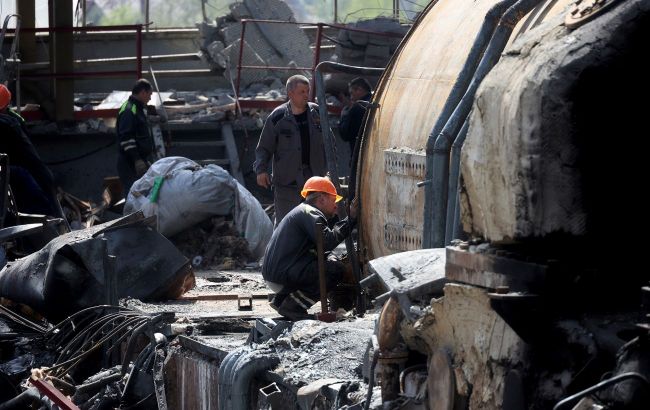Ready for terror: How many missiles and drones Russia stockpiled to attack Ukraine's energy sector
 Russia may continue to strike at Ukraine's energy sector (photo: GettyImages)
Russia may continue to strike at Ukraine's energy sector (photo: GettyImages)
On November 17, Russia attacked Ukraine's energy sector again for the first time in several months. These massive strikes are likely to continue, given that Russia has accumulated enough missiles. How Moscow has changed its tactics and how many means it has to do so read in the article by RBC-Ukraine.
Russia has launched a new campaign of attacks on the Ukrainian energy sector. It has more than 1,500 missiles in its arsenal due to increased production and a pause in shelling, according to data obtained by RBC-Ukraine from informed sources. And the change in attack tactics allows the Kremlin to cause damage to Ukraine's energy system.
Our informed interlocutors predict that at least until the inauguration of US President-elect Donald Trump, Russia will escalate the situation as much as possible and raise the stakes. Therefore, if we choose one of the scenarios - whether Russia will destroy the Ukrainian energy sector in the coming months or wait for some steps from the new head of the White House - the first one looks more realistic.
What Russia changed in its shelling tactics
Russia has learned lessons from its attacks on the Ukrainian energy sector in 2022-2023. Then, with predictable regularity, Russia struck at Ukraine's energy facilities with Shaheds, Kh-101 missiles, and less often with sea-based Kalibr missiles. After a short blackout in November 2022, Ukrainian power engineers realized how to counter this scenario in the future. Russian shelling of the power grid continued until March 9 of the following year, but starting in mid-February, most consumers across the country had electricity around the clock.
There were many fears that the aggressor would again organize a campaign of attacks on the Ukrainian energy system with the heating season in 2023. And it did begin, albeit with a delay, a few days after Putin's election in March 2024. Unlike the 2022-2023 season, Moscow has revised its tactics and attack scheme. Unfortunately, they proved to be effective. And Russia will likely follow the same plan during the current campaign.
 Russia has changed its missile strike tactics (photo: RBC-Ukraine, Vitalii Nosach)
Russia has changed its missile strike tactics (photo: RBC-Ukraine, Vitalii Nosach)
First, in 2022-2023, each Russian massive attack was focused on a separate segment of the power grid. For example, during one attack, the strikes were mainly on thermal power plants, during another - on hydroelectric power plants, during yet another - on substations leading from nuclear power plants, and Shaded drones usually struck transformer substations. In March 2024, Moscow began to strike at different elements of the grid at once, sending not one but several missiles at once.
Second, Russia has begun to launch combined strikes. It has moved away from the previous schedule when the country was terrorized by kamikaze drones at night and cruise missiles during the day. Kinzhals and ballistic missiles have also been used, and Shaheds often fly simultaneously with missile weapons. Given that Patriot-type systems protect a relatively small area of Ukraine, ballistic missiles were almost guaranteed to hit a selected energy facility and cause damage.
Third, Moscow has changed the interval between attacks. In the fall of 2022, massive strikes were carried out every 7 days, then every 10 days, and in the winter of 2023 - every 14 days, in the spring of 2024, Russia increased this frequency. For example, the first strike took place on March 21, the next one of a similar scale on March 22, and then on March 24, 29, and 31. In between, the Kremlin systematically attacked various regions with Shaheds At the same time, Russia tried to achieve the greatest possible surprise effect by periodically mixing real and simulated launches.
By early April, the government reported that in two weeks Russia had knocked out more than 6 gigawatts of capacity from the Ukrainian power grid. This includes both hydropower and coal power. In thermal generation, Russia destroyed 80% of the capacity.
Russian shelling continued with less intensity in April, May, June, July, and August. In September, October, and the first half of November, the Russians focused on launching Shaheds whose main target was not energy. However, on November 17, after a week of training and practicing simulated and combined strikes, Moscow again tried to attack Ukrainian thermal power plants, hydroelectric power plants, and substations. Probably, it waited until the Ukrainian energy sector managed to repair some of the damaged facilities.
After the attack, Odesa plunged into a local blackout for a day, and blackout schedules returned to the capital, Kyiv, Dnipropetrovsk, and Donetsk regions. And we can assume that Moscow will not stop there.
Moscow's situation with missiles and Shahed drones
According to the agency, Russia has managed to accumulate a sufficient number of missiles with a range of more than 350 kilometers. In addition, Russia, despite all the sanctions imposed, has been able to increase production rates for certain items over the past year. While a year ago, the monthly volume was measured at 115-130 strategic missiles, now, according to RBC-Ukraine, it is about 170. Among all the items, Moscow has increased production of ballistic Iskanders the most.
According to the agency's sources, Russia plans to produce about 70 Iskander-M missiles in November, and its stocks as of November 20 amount to 350 units. The plan for the production of cruise missiles for Iskander in November is 12 units, with a stock of 210.
If we talk about the Kh-101, their production in November should reach 50 units, and the stock as of November 20 should be 220. And now Russia has begun to launch them not only from Tu-95s but also from Tu-160s, which was hardly ever recorded before. During the shelling on November 21, Russia again fired several Kh-101 and Kinzhal missiles at Ukraine. Moscow has managed to accumulate the most Kalibr missiles: as of November 20, Russia has about 390 of them in its warehouses, and 30 are scheduled for release in November.
As for the Kinzhals, their stockpile is 70 missiles, and the expected production in November is 12 units. In addition, Russia may have about 230 Kh-22s (Tu22M3 carriers) in its warehouses. Russia no longer produces them, but every month it carries out a deep modernization of a dozen of them, getting Kh-32s as a result. Plus, according to RBC-Ukraine, Moscow may also have about 45 North Korean KN-23 ballistic missiles in stock.
Another problem for Ukraine is the Russian-Iranian Shahed drones. Since September, Russia has been launching dozens of these kamikaze drones almost every night in different regions of Ukraine to deplete and reconnoiter our air defense. According to RBC-Ukraine, not all of the launched drones are the so-called Geran, they are combined with other long-range UAVs, such as the Gerber, for a larger volley. However, the volume of production of even the most Shaheds-Gerans allows Russia to terrorize Ukraine every night. According to RBC-Ukraine, Russia plans to assemble about 900 units of such drones per month with the help of components provided by Iran. This is 3 times more than last year's figures.
All of these figures confirm that no sanctions will prevent Russia from launching massive strikes on Ukraine's critical infrastructure if it hatches such a plan. Therefore, the resilience of the Ukrainian grid for this fall and winter season primarily depends on Ukrainian soldiers and air defense systems, the skill of Ukrainian power engineers, and the availability of at least some protection at power facilities.

